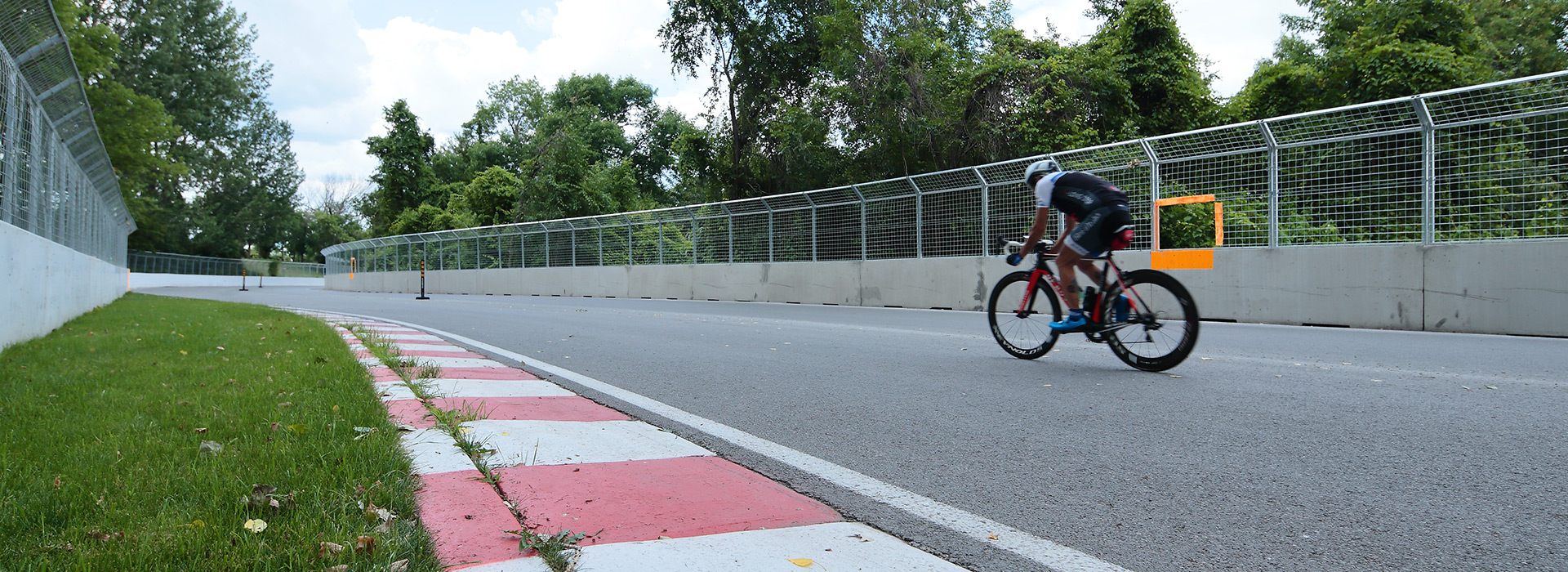Formula One weekend dominates Montreal in June, with groups of tourists wearing team-branded caps meandering around the city, and taking in the sights. This year, Formula One weekend was cancelled, along with all the events that surround it. Roaring engines, cheering crowds, and screeching tires have been replaced by the clicking of free-wheeling bikes and rustling trees near the race track.
With Formula One weekend called off, one might expect Circuit Gilles-Villeneuve—the 4.3-kilometre-long track on Île Notre-Dame—to lay idle and gather dust. Anyone who frequents the island, however, knows that this is not the case. For decades, the race track has been converted to a closed cycling route when not in use. While most public gatherings have been shut down this summer due to COVID-19, the cycling community has thrived.
Every day, Montrealers young and old don their colourful spandex cycling kits, clip in to their pedals, and bike over Pont Jacques-Cartier to the circuit where dozens of cyclists, putting in laps, are waiting for one more person to join their pack.
Circuit Gilles-Villeneuve was constructed in 1978 for the Canadian Grand Prix following growing safety concerns with the previous track, Ontario’s Mosport Park. Montreal’s track was built on roads constructed earlier for Expo 67, and was ideally located near the city. Since its construction, the track has become an adaptable and versatile venue for sports, the arts, music, and nature preservation.
The Circuit offers a cycling experience that is truly like no other. The closed path is a space for pedestrians and cyclists only, providing a stress-free environment for anything from a promenade to a high-intensity tempo workout. The gently curving roads make for an exceptional riding experience, offering an escape from the city.
Since its inception, the track has developed a reputation for intense cycling competition and training. Teams from the national to the university levels, including Cycling Canada, and McGill Cycling, regularly hold training and racing sessions on the circuit. These teams take advantage of the ideal road conditions and high caliber of competitive riders that the circuit attracts. The widely used cycling app Strava has publically available Heatmaps, which visualize the frequency at which a route is used. Strava has made evident that this track is one of the most heavily-used cycling roads in Montreal.
President of McGill Cycling Nick Kleban shares this enthusiasm for the circuit.
“The Circuit-Giles Villeneuve is definitely one of the go-to riding spots in Montreal,” Kleban said in a message to The McGill Tribune. “It provides cyclists with an easily accessible location to ride and train away from the regular city traffic. It also acts as a hub to meet other local cycling enthusiasts [….] Riders flock there for everything from easy spins to fast group rides. Historically [it is] one of McGill Cycling’s staple rides, [and as such] the Team Points Race (TPR) was hosted every Tuesday morning on the track.”
Anyone looking to see the track at its busiest should head over on a Wednesday night. Cyclists from all around the city congregate at Cafe Le Club, drink espresso, and head across the bridge for a night of cycling. Pace lines form, grow, and kick their bikes into their highest gears, all in an attempt to break coveted speed records on Strava.
So beloved is the circuit that in 2017, when the city attempted to cease bike access to the track, cyclists banded together to preserve their home. The closure came from the Société du Parc Jean-Drapeau, who had safety concerns regarding the construction of a 65,000-seat amphitheater nearby. A Facebook group with nearly 6,000 members banded together to voice their grievances. With the help of groups like Vélo Québec, a non-profit bike promoting group, they succeeded in keeping the track open. Since then, the circuit has remained open every summer.
The circuit has also provided a fantastic place to display outdoor art installations. In the surrounding park there are several sculpture gardens showcasing Indigenous art, modern sculpture, and outdoor photography exhibits. Many of the exhibitions feature the work of local artists.
So whether you’re a serious cyclist, casual Bixi-er, or just looking for a nice walk, make the journey over to Parc Jean-Drapeau and take advantage of the open road, art installations, and city views before the snow sets in.






